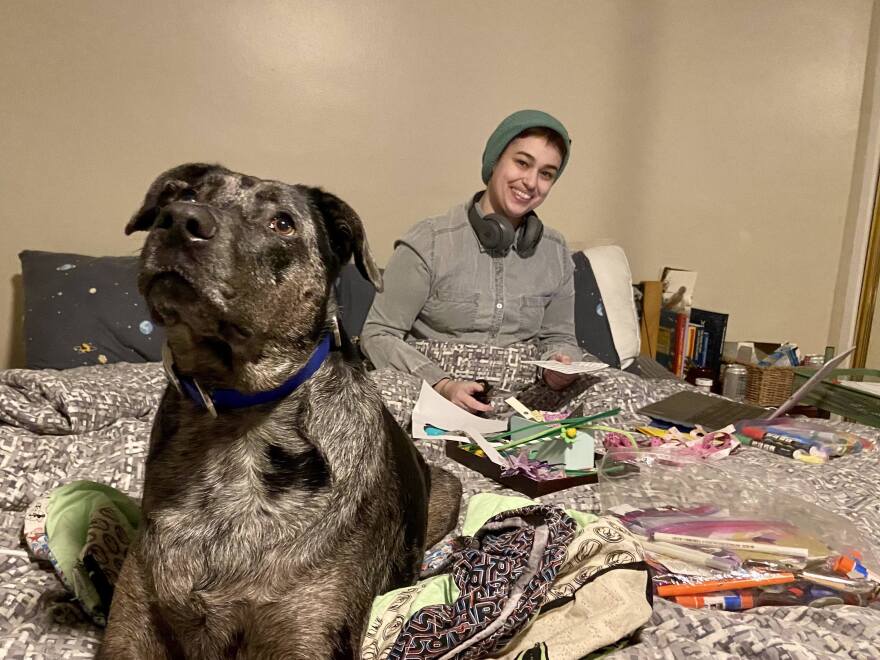On a blustery day in Los Angeles, Mimi Newman unlocks her front door to take the dogs outside. For Newman, "outside" is a relative term — she's been in strict quarantine since March 6, 2020. She's only gone past her front gate three times.
Newman is severely immunocompromised. To a small degree, her medical history prepared her for the pandemic.
"I have had periods of my life — years and years and years — where I had to be either in bed the whole time, or just not able to leave the house 'cause I had been so sick," she says. "But it's so different when anyone that could walk through the door could essentially kill you with their breath."

So for the past year she's been nannying a 9-year-old over Zoom, supervising cake baking and attending Morning Sing from bed. "We have done sewing. We have done making paper flowers out of tissue paper. You name it, I've crafted it," she says. "I even bedazzle."
Californians with high-risk disabilities, such as heart failure and chronic pulmonary disease, had been eligible for the COVID-19 vaccine in the state's tier 1C. But in January, after opening tiers 1A and 1B, California joined states like Connecticut and Indiana in pivoting from a risk-based strategy to an age-based one. That meant Newman, who's 31, would have to wait until mid-March.
Many states are rolling out the vaccine in tiers that prioritize people using a variety of factors, including age, occupation, and risk factors such as preexisting conditions.
The state's plan has led to some odd loopholes. Landscapers and massage therapists became eligible for vaccines in early February, as did Newman's wife Megan, her primary caretaker.
"It seems particularly fitting that they decided to categorize my wife as more eligible for vaccination than me," says Newman. "It's literally saying, 'We are going to keep her safe instead of you.'"
Age-based vaccine systems are the norm: think of the shots needed for school. But things change in a pandemic, when everyone needs a shot at the same time. There is widespread agreement that healthcare workers should take priority. But almost immediately after that, things get messy.
"As we go down the ladder, it gets more and more complicated," says bioethicist Jen James. "How do we weigh teachers against people with disabilities or chronic illnesses? Those questions of individual value, of who quote-unquote deserves a vaccine more or needs a vaccine more, are directly butting heads with: Who do we need to be vaccinated for the good of our society?"
There's also the basic difficulty of getting shots into arms. "The infrastructure limitations are huge in California," says infectious disease specialist Dr. Peter Chin-Hong. "California is not only the most populous state, but a huge landmass with a lot of rural areas."
With that in mind, an age-based system has two clear advantages. "Every decade above the age of 50 results in an increase in mortality from COVID-19," says Chin-Hong. "The other aspect is one of logistics: it's easily possible to adjudicate what somebody's age is."
Dr. Louise Aronson is a member of the California Department of Public Health's Priority Population Workgroup, which helped set the vaccine tiers. "We looked at socio-demographic groups, we looked at illness categories, we looked at combinations of illness," she says. "If you look at people who have three or more chronic conditions, that is another thing where the risk for serious illness and death goes way, way up."
But sometimes that risk is obscured by a lack of data. "There are rare conditions that probably put people at really high risk, but they're rare, so they don't get quantitated," says Aronson. And in a state as large as California, going by the numbers is both necessary for an effective rollout and bound to exclude people like Mimi Newman.
So much of the human toll of this pandemic is hidden away from view, from solitary deaths in ICUs to people with high-risk disabilities in tight lockdown.
"Seeing people sitting in Beverly Hills, eating outside with no masks on: it's those kind of tiny pickaxes that eat away at me," says Newman. "It hurts to know that there are the people who think, 'Oh, just this once. Just this once isn't bad.' I don't know any other world than the one that is people who are staying inside and dying."
On March 15th, Newman will join up to six million other Californians newly eligible for the COVID-19 vaccine. In the meantime, she's entering the second year of the pandemic exactly where she started the first: inside, waiting.
Copyright 2021 NPR. To see more, visit https://www.npr.org. 9(MDAzODUzOTQwMDEyNDk2NzQ5ODE5OTFmNQ004))







